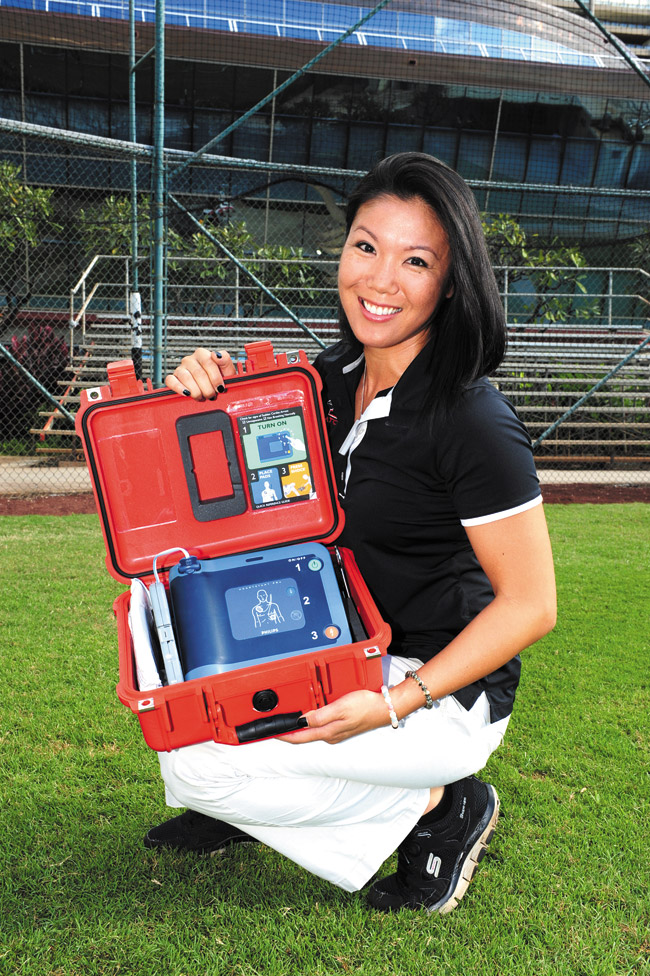Lifesaving AEDs Right On Campus

Iolani School athletic trainer Louise Inafuku with an automated external defibrillator | Nathalie Walker photo
On Feb. 12, 2014, Louise Inafuku was in the athletic training room at Iolani School when one of the school’s baseball players ran in and said a coach was down. He had collapsed on the baseball field.
Immediately, she ran outside with an automated external defibrillator (AED) in hand.
“As soon as I saw him, I knew he was in cardiac arrest,” she recalls. “I placed the AED pads on him, it analyzed and said to shock him once, so I did. It analyzed again and said no shock advised, so I went straight to the chest compressions and we did some rescue breathing.”
In the meantime, 911 was called. Within five minutes firefighters arrived, followed by EMS shortly after.
The coach survived and is reportedly doing well.
There also have been two other incidents within the past two years at Iolani where the AEDs were used on cardiac-arrest victims. Both also survived and are doing well.
“The first incident was in May 2012 and involved one of our faculty members,” explains Inafuku. “He had some of the symptoms and knew something was not right, so he walked into the infirmary, where he collapsed. The school nurse applied the AED and initiated everything, and I was called over to assist.
“The second one was a visiting water polo parent, so that happened by the pool.
The AED was brought out and I was called. But by the time I got there, I believe one of the parents was a nurse and she applied the AED to the parent.”
According to American Red Cross, a victim’s chance of survival (from sudden cardiac arrest) decreases by 7 to 10 percent for every minute that passes without defibrillation, so placing AEDs in key locations and making sure people are trained to use them can mean the difference between life and death.
Iolani started installing AEDs in 2006 and has 17 devices spread throughout its campus.
“Anyone on campus has access to the AEDs,” notes Inafuku. “None of the ones mounted on the wall are locked, so anyone can open the cabinet door, and an alarm will go off to indicate the AED is being used.
“Most people are hesitant to use it because they’re, like, ‘I don’t know how to use it’ or ‘I don’t want to harm them.’ But it’ll walk you through it as soon as you turn it on.”
Inafuku says in addition to staff and faculty, all of the ninth- and 11th-graders are trained to use the AEDs.
“We want to empower the students to not be afraid to at least initiate CPR while someone else is getting help,” she says. “We don’t want them to think it’s only the medical staff that is able to save lives.”
There were about 40 students who witnessed the most recent incident, which occurred during baseball practice. “A lot of them came up to me, thanked me and gave me a hug, and that was really nice,” shares Inafuku. “I think a lot of them were very affected by experiencing that.”
March is National Athletic Training Month, which recognizes the work of athletic trainers, including Inafuku, who also is president of Hawaii Athletic Trainers Association.
At Iolani, Inafuku is one of two full-time athletic trainers on staff. The school also has two part-time trainers.
“Personally, I feel very blessed to have been there and to have assisted,” says Inafuku. “And I’m very happy that all three incidents have turned out to be very positive.”
yting@midweek.com





